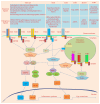Psoriasis is a chronic inflammatory autoimmune disease that can be initiated by excessive activation of endosomal toll-like receptors (TLRs), particularly TLR7, TLR8, and TLR9. Therefore, inhibitors of endosomal TLR activation are being investigated for their ability to treat this disease. The currently approved biological drugs adalimumab, etanercept, infliximab, ustekinumab, ixekizumab, and secukizumab are antibodies against effector cytokines that participate in the initiation and development of psoriasis. Several immune modulatory oligonucleotides and small molecular weight compounds, including IMO-3100, IMO-8400, and CPG-52364, that block the interaction between endosomal TLRs and their ligands are under clinical investigation for their effectiveness in the treatment of psoriasis. In addition, several chemical compounds, including AS-2444697, PF-05387252, PF-05388169, PF-06650833, ML120B, and PHA-408, can inhibit TLR signaling. Although these compounds have demonstrated anti-inflammatory activity in animal models, their therapeutic potential for the treatment of psoriasis has not yet been tested. Recent studies demonstrated that natural compounds derived from plants, fungi, and bacteria, including mustard seed, Antrodia cinnamomea extract, curcumin, resveratrol, thiostrepton, azithromycin, and andrographolide, inhibited psoriasis-like inflammation induced by the TLR7 agonist imiquimod in animal models. These natural modulators employ different mechanisms to inhibit endosomal TLR activation and are administered via different routes. Therefore, they represent candidate psoriasis drugs and might lead to the development of new treatment options.
Health News
In the present study, we investigated the effects of antrodin C (ADC), a maleimide derivative isolated from mycelia of Antrodia cinnamomea, on high glucose (HG, 30 mM)-accelerated endothelial dysfunction in vitro. HG-induced cytotoxicity in human umbilical vein endothelial cells (HUVECs) was significantly ameliorated by ADC. In addition, treatment with ADC significantly prevented HG-induced senescence, growth arrest at the G1-S transition phase and apoptosis in HUVECs. Moreover, the increased level of intracellular reactive oxygen species (ROS) under HG condition was significantly ameliorated by ADC. Further analysis revealed that ADC-mediated anti-oxidant effects were due to up-regulation of cellular anti-oxidant genes, such as HO-1 and NQO-1 via promotion of the transcriptional activity of Nrf2, which was further confirmed by the failure of ADC to protect HUVECs from HG-induced dysfunction under HO-1 inhibition or Nrf2 silencing. Furthermore, hyperosmotic glucose (HOG, 60 mM)-induced uncontrolled production of ROS, rapid apoptotic cell death and HUVEC injury were significantly prevented by ADC, whereas these preventive effects were barely observed in HO-1 inhibited or Nrf2 silenced cells. Taken together, these results suggest that ADC may represent a promising intervention in diabetic-associated cardiovascular diseases by activating the Nrf2-dependent cellular anti-oxidant defense system.





